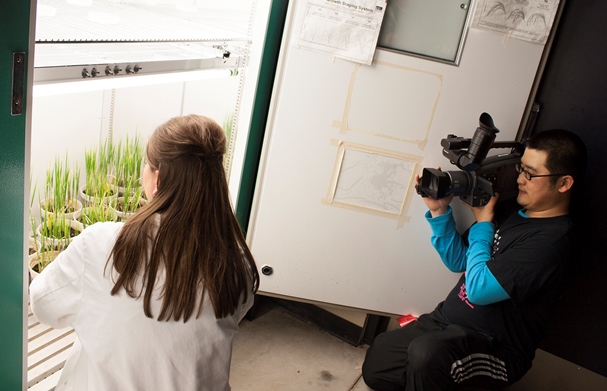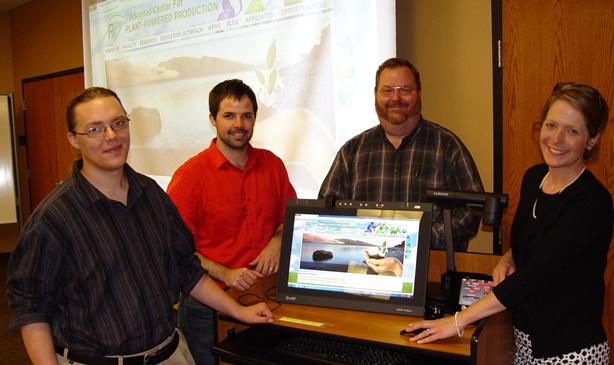A-State Student Communicators Help Explain Research for National Science Foundation EPSCoR Project
JONESBORO – If the director of a research center at Arkansas Biosciences Institute (ABI) were highlighting the work of one of the faculty, she might say something like, “Increasing the levels of the antioxidant ascorbic acid in rice through manipulation of myoinositol oxygenase enhances tolerance to abiotic stress.”
Outside her field, few people would have any idea what Dr. Carole Cramer was saying about research at the Arkansas Center for Plant Powered Production (also known as P3).
However, in a video produced by A-State's College of Media and Communication students, she might say, “Today’s heat index in Arkansas is 109 degrees. It’s hot for us . . . and it’s really hot for our rice crops in the field. Graduate student Katie Lisko has discovered a way to up the vitamin C in rice plants, and that protects rice from the devastating impacts of drought and high heat. Happy plants give more rice!”
The research center receives funding from the Experimental Program to Stimulate Competitive Research (EPSCoR), a division of the National Science Foundation (NSF). NSF leadership has encouraged EPSCoR projects to improve public understanding of their work and its impact.
In response, Emily Devereux, P3 program manager, developed a proposal to use social media, such as Facebook, Twitter and YouTube, for communicating the scientists’ work and outreach goals.
“We realized we needed resources outside the scientific community,” she recalled. “I met with Collin Pillow in the Radio-Television Department and discussed having students from the College of Media and Communication produce research communication videos. We agreed that engaging communication students with the social media proposal could be highly beneficial.”
Pillow’s spring semester class in “Advanced Internet Communications,” composed of senior and graduate-level students, went to work on the challenge.
“The P3 project was a perfect fit for this class, which allows students to investigate how to use technologies to improve the communications process,” Pillow explained. “The P3 team benefited by being exposed to new communications methods, and our students enhanced their educational experiences by interacting with a ‘client’ and helping the team achieve their goals.”
The class identified key components of a P3 communications strategy then divided into project teams based on experience and personal interest.
NSF has a long history of funding innovative research and STEM (science, technology, engineering, and mathematics) education. According to Dr. Denise Barnes, head of EPSCoR, “It is imperative that those funded by NSF be able to communicate in a clear, concise, and compelling way the outcomes and impacts of taxpayers’ investments and do so in a manner that is easily understood by a diverse group of stakeholders who span broad technical literacy levels.
“Effective communication can help all stakeholders grasp the societal benefits of NSF-supported research and education,” she continued. “As such, I am so pleased with the collaborative efforts between the P3 students and researchers and the communication students, yielding a portfolio of communication approaches to improve public understanding of research.”
Devereux said one of the "golden moments" of the project was the use of focus groups involving P3 students and researchers and the communication students.
“The focus group sessions were successful in getting both parties inspired to communicate and to translate P3's science research to the community,” she said. The project has been reflective of Arkansas State University’s mission to educate leaders, enhance intellectual growth and enrich lives.
Andrew Bearden of Jonesboro, a senior graphic communications major in the College of Media and Communication, added, " ‘The four pathways that plants use vitamin C’ became a recurring theme of the focus group discussions. As a class, we were forced to dig into the subject matter and research it on our own before we were able to reassign more understandable explanations.”
Jon David Carmack of Jonesboro recalled, “Meeting with P3 representatives helped us and gave us insight into their groundbreaking research, as well as giving them a glimpse into how our generation communicates and networks." Jackson Spencer, also of Jonesboro, added, "Social media initiatives are appealing to a younger generation that utilizes online communication every day."
Bearden noted the P3 faculty and students put their faith behind the students and listened closely to suggestions. The communication students talked extensively among themselves to grasp the concepts.
The spring project led to a summer internship with P3 during which he expanded on the class work. This opportunity to engage more seriously in his craft will conclude with his graduation later this week.
The collaboration between P3 and the College of Media and Communication was enthusiastically received at the NSF/AR EPSCoR annual conference. Dr. Kent Chapman of the University of North Texas and member of the AR EPSCoR External Advisory Board called the collaboration a “fresh perspective” and “tremendous tool” for presenting science.
The project also will help promote science in K-12 education as well as workforce development, explained Shea Harris, P3 outreach coordinator. ABI scientists are referencing links to the social media content in research proposals.
"Funding agencies like to see how well we communicate the research they will be potentially funding," Devereux added.
# # #







